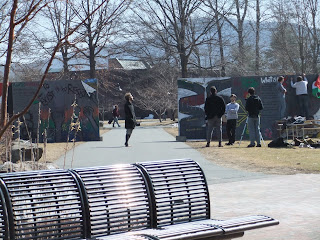
How does one determine the date of a sacred event? Traditionally, both Judaism and
Islam relied on lunar observation to set the calendar, and the difficulty of communicating the news over long distances led to uncertainty. Diaspora Judaism solved the problem by
simply adding an extra day to major holidays, for safety’s sake. And “Israeli Apartheid Week”? Well, it begins with the month of March, but when it ends is anyone’s guess. It lasted five days in its original incarnation, but in some places today, runs as long as twelve or fourteen (unless there’s a special deal: for you, seven!).
As I wrap up my coverage of our local festivities, I therefore wanted to make sure they were really over. Today is the 15th, so I should be safe. In fact, there’s been no visible activity for almost a week.
Let me, then, take you back to the (anti)climax.
March 6 was one of those glorious pre-spring days when the sun shines and the temperature tops 50 degrees Fahrenheit, and everyone, frustrated at having been cooped up during the New England winter, surges into the great outdoors. For better or worse, it was also the weekend, and what is more, the first (or only? see above) Saturday of “Israeli Apartheid Week.”
Sure enough, when I came downtown in the early afternoon, I spotted the dreaded hordes of shouting students. In fact, many were even wearing the tell-tale symbolic green of the faithful. As it turned out, though, they were all lined up in front of McMurphy’s tavern, and it was the green of Saint Pat rather than Hamas.

By contrast, over at the nearby Town Common, where the “Israeli Apartheid Wall” had just been erected, the scene was dead.

In fact, all the action was taking place on the blank backside of the wall, where students picnicked, oblivious to the great political crimes being pilloried but yards away.

And the fearsome construction itself?
Pretty much a joke, as well. Graphically, it was a disorganized mess. Intellectually, too, it used a “spaghetti against the wall” approach: throw everything up there, and hope that something sticks in the minds of the onlooker.
It contained a potted history of the Middle East conflict far too ludicrous to
fisk here.

A few examples will have to suffice:
(1) “1920-The British Occupy Palestine.” Uh, no.
The British army conquered the Ottoman territory in 1917-18 (do students no longer know the dates of World War I? well, they would if they took my classes). In 1920, the San Remo Conference assigned to Great Britain the
League of Nations Mandate for Palestine. That still-binding document, which under the “international law” that activists so love to cite, authorized “the establishment of the Jewish national home,” went into effect in 1922.
(2) “1967-War; Israel annexes Gaza and the West Bank.” Sorry: never happened. The standard view is that Israel “annexed” only East Jerusalem, though even that is
debatable, as it merely extended unified administration to all sectors of the city. There’s no mention of the "annexed" Golan Heights or the vast Sinai Peninsula (returned to Egypt), presumably because Palestinians do not claim them, and yet this omission completely and conveniently removes the context for the 1967 conflict, which was a major international war—Arab-Israeli rather than Israeli-Palestinian.
(3) More telling still, the overall logic is thus reminiscent of
a magical rather than scientific mentality. Terrible things just happen without evident causation: “war ensues” (or more often, “war” is left an orphan, without even a verb for company). The standard set of
propaganda maps, showing Israeli territory increasing and Palestinian decreasing, is thus presumed to speak for itself and send a message of relentless Jewish expansionism. Actions of the Arab side—most notably, rejection of a Palestinian-Arab state in 1947, and aggression in 1967—are conveniently absent.
(4) “1948 War, the
Nabke [emphasis added]. 750,000 Palestinians displaced.”
Uh, . . . that’s “
Naqba” (or: Nakba), activist dudes!!
The reference of course is to the Arabic term for “disaster” as a description of the war and the creation of the refugee problem: the absolutely central element in the Palestinian national narrative.
It would be like a Jew referring to the “Hokolaust.” Whoops.
Need one say more? The inability to get such fundamental facts and terms right speaks volumes. No need even to try to make sense of the bizarre depiction of other border barriers around the world, which not even the addition of the gratuitous epithet, “el muro fascista,” can rescue from graphic and conceptual incoherence.



Very few passers-by paused to engage in the desired conversation, or even to look. The only real activity I saw was the group’s videographer filming other activists:


* * *
The Wall moved to Hampshire College on Monday, March 8, where it garnered about the same amount of attention—and this, at the lunch hour on another warm and sunny day, when activity on central campus is at its height:

Once again, only the (now expanded) video crew was really in evidence: the monotonous monologue of activists talking about—and to—themselves.


An exercise in sheer self-gratification.
Twilight of BDS: a metaphor?
This was the scene shortly after 5 p.m. Even less action.

My suggestion: Drop the name, “Apartheid Wall,” and call it what it is: the “Apathy Wall.” No one cares. (In fact this seems to be
the trend around the country.)
To be sure, SJP tried to cajole or provoke the apathetic masses into developing a suitable revolutionary consciousness by plastering the campus with "clever" flyers that invited community members to share their negative reactions and take the opportunity to inform themselves about the heroic action. Yeah, right.

Give ‘em points for trying, but few students were gullible enough to fall for that one. Even assuming they were both curious and naïve, they had papers to write, and spring break was less than a week away. You do the math.
It’s like what happened when the SJP kids tried to promote the
first anniversary of their failed divestment attempt last month. Eager activists surged through the dorms, waking everyone up and exhorting all to celebrate and meditate on the great victory—at 8:00 a.m.
This certainly reveals a failure to understand what the old Marxist-Leninists used to call the subjective as well as objective conditions for revolution. Translation: no matter what his or her politics or preceding nocturnal activities, every normal college student wants to sleep in on Sunday morning.
The only response, on both occasions was: a big yawn.
Who says college students have no common sense?



























